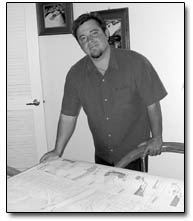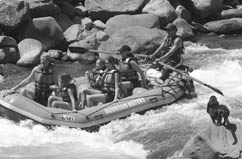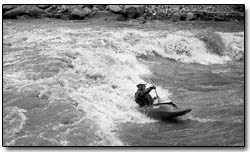 |
| A kayaker plays below Smelter
Rapid earlier this week. Two local men, Aaron Lombardo and
Forrest Jones, started a business to design whitewater parks
and river play features in towns throughout the country.
/Photo by Todd Newcomer. |
In the past several years,
one man’s name has become synonymous with whitewater parks
in Colorado: Gary Lacy. But that could soon change if a couple
of enterprising Durango men have a say.
Aaron Lombardo and Forrest Jones recently started Hydraulic
Design Group, the newest entrant in the rapidly expanding world
of whitewater parks. And armed with many years paddling experience
between them, they intend to give Lacy a run for his money.
“We saw the need for some alternative river parks,”
said Lombardo, adding that while Lacy’s designs are popular,
he has heard from several pro paddlers who are looking for more
out of the whitewater park experience. “What we want to
do is make world-class features that are up to standards to
facilitate world-class events.”
 |
Lombardo stands with plans for a
Glenwood Springs whitewater park.
His company, Hydraulic Design Group,
competed against Gary Lacy to design
the project. /Photo by Missy Votel |
As an example, he points to Durango’s own crown jewel,
Smelter Rapid. The rapid, which has been tinkered with several
times over the years, is slated for work this fall under the
direction of a community task force made up of river users and
stakeholders.
“What Lacy typically does is take C- rivers and turn
them into C+,” said Lombardo. “But what we have
here is a B+ or A- river that we just may want to fix.”
Lombardo also said his desire to enter the field was born of
a need to help the environment.
“I want to make more play parks in cities so people don’t
have to travel long distances just to paddle and burn fossil
fuels,” he said.
Lombardo said he and Jones decided to join forces professionally
after working with other community members to build a play hole
downriver from Smelter in 2000.
“Basically, it was spurred from building Corner Pocket,”
he said.
The hole, which has withstood three years of run-off, has gained
a dedicated following among the local and national paddling
community, he said.

The City of Durango has replaced the
Boulder company hired to work on Smelter Rapid this fall,
opting instead to use local resources.
“Representatives from the local
river community requested that we take a different direction
and utilize the expertise we have locally and see if we
can come up with a design and work together on that,”
said Cathy Metz, Durango director of parks and recreation.
Last year, Gary Lacy, of Recreation Engineering
and Planning, was contracted by the city to make improvements
to whitewater features at Smelter. However, there was
opposition to his plan as well as the use of an outside
company to do the work.
“We decided not to pursue the services
of Gary Lacy and are going to pursue another method of
community involvement,” said Metz.
She said the city is forming a task force
of river users and stakeholders to steer the Smelter project.
The group will also be responsible for coming up with
a master river-use plan for work done beyond Smelter,
as required by the Army Corps of Engineers. Right now,
the city has identified 10 other sites on the Animas for
potential whitewater development.
Metz said the task force is still in
the process of forming, and no date has been set for its
first meeting.
“I imagine, if all goes well, we’ll
have our first meeting this month,” she said.
She said if the group reaches consensus,
work on Smelter Rapid could begin this fall.
“There’s a specific time
period set by the Army Corps of when we can do work,”
she said. “It would be early fall if we do go in.”
|
“World champion Eric Southwick said it was the best hole
in the 11-state area,” said Lombardo.
And while Jones and Lombardo scored a coup with Corner Pocket,
as local paddlers may know, they were not so lucky with work
that was performed on Smelter that same year. With the force
of the following spring’s run-off, a rock in the hole
shifted, creating a strong “keeper” hydraulic at
certain water levels.
Lombardo said that shifting rocks and mutating features go
with the territory, adding that two of Lacy’s recent projects
– one in Salida and one Steamboat Springs – met
similar fates. Without the use of grout, or cement, to hold
rocks in place, most manmade river features will require regular
maintenance, he said.
“Does the city build a park and then never come back
to water the grass? You have to have maintenance,” he
said.
Nevertheless, Lombardo said he and Jones learned a lesson in
humility from the Smelter experience, particularly how to reconcile
the desires of different user groups.
“We definitely learned a lot from that,” he said.
“Enough to know how to deal with communities and go about
it.”
And although grout often is the answer to avoiding such calamities,
it is not always the most popular one. As a result, Lombardo
said his company is trying to come up with alternatives.
“We are working on some different ideas other than grout,”
he said.
Lombardo is banking on innovation and a staff of experts and
consultants to make his company competitive with Lacy. Recently
Hydraulic Design Group brought Nick Turner, a civil/hydraulic
engineer and whitewater park designer from Bozeman, Mont., on
board.
“Nick has a whitewater park business and did a few projects,
and we basically joined forces to make one company,” Lombardo
said. “He can take our designs and run flow studies on
the computer to see how they’ll work.”
The company also uses local environmental consultant Sean Moore
to help with obtaining Army Corps permits and mapping, and employs
the help of professional freestyle boater Jimmy Blakely with
design.
Nevertheless, Lombardo notes that taking a bite out of Lacy’s
monopoly is a sort of chicken-and-egg scenario.
“Until we get our first job and prove ourselves, it’s
going to be tough to compete against him,” he said.
 |
Local boater Luke Hanson plays in the
Corner Pocket wave earlier this year./Photo
courtesy Aaron Lombardo. |
In the meantime, Hydraulic Design has gotten its foot in the
door, Lombardo said, going head-to-head against Lacy for several
jobs, including one in Glenwood Springs (the outcome of which
has yet to be decided). The company also is creating a feature
later this year for the Colorado Timberline Academy north of
town and is working on feasibility studies for Telluride and
Rangely.
“We are working on conceptual design, cost analysis,
surveying the river bed and talking to community members about
what they’d like to see,” he said.
He also has offered up his company’s services to the
City of Durango for the Smelter work.
“I’ve offered my team’s expertise on a volunteer
basis to the city if needed,” he said. “It could
potentially save Durango $100,000, at least. We would be working
with people that represent each river user group on a task force
that’s going to answer to the city.”
And while they many never unseat Lacy as the king of Colorado
whitewater parks, Lombardo notes that the field is still relatively
new, and there’s plenty of room for newcomers.
“If Colorado is setting an example, play park growth
is going to explode,” he said. “There are 15 in
Colorado. Just imagine how many towns there are across the country
with rivers running through them.”

